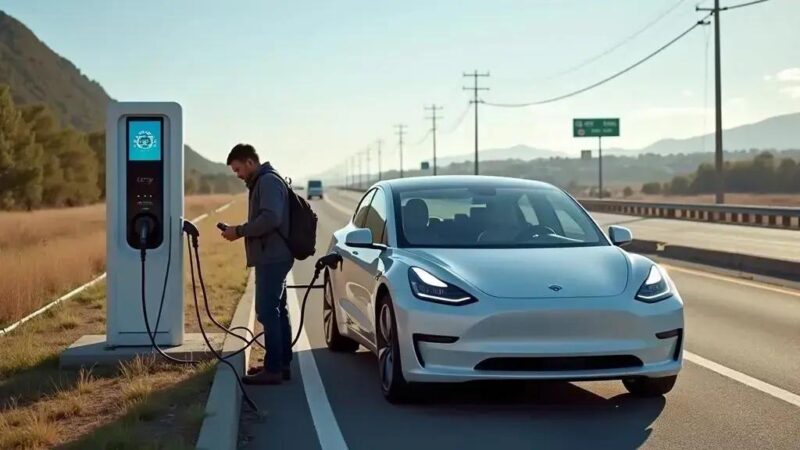EV charging is expanding across highways and towns — yet many Americans still hesitate because of range, time and cost concerns. Curious how new fast chargers, real road trips and policy shifts reshape that reality?
Fast-charger rollout: growth, coverage and highway access
The number of electric vehicle (EV) fast chargers is growing quickly across the U.S. This expansion makes it easier for drivers to power up their cars on the go. Many new stations are popping up along major highways. This helps people feel more confident about taking longer trips in their EVs.
Government programs and private companies are working together. Their goal is to build a strong network of charging points. You can now find fast chargers every 50 miles or so on many key routes. This means less worry about running out of battery far from home.
Fast-charger rollout is a big step forward for EV adoption. These powerful chargers can add hundreds of miles of range in a short time. This makes road trips much more practical for EV owners. The focus is on creating seamless travel experiences, just like with gas stations.
More and more towns are also getting new charging options. This wider coverage helps daily commuters and local drivers too. It shows a clear commitment to making EV ownership simple and convenient for everyone.
Range anxiety vs. reality: road trips, polling and user experiences
Many people worry about how far an electric vehicle (EV) can go on one charge. This feeling is called range anxiety. It’s a big reason why some folks hesitate to buy an EV. They fear getting stuck far from a charger, especially on long road trips.
However, the reality for EV drivers is often different. The charging network is growing fast. This means more places to plug in, even on highways. Surveys show that while range anxiety is common before buying, it often lessens once people own an EV.
Real-world road trips prove EVs can handle long distances. Drivers plan their stops, just like with gas cars. Apps help find chargers along the way. Many EV owners share positive stories about their journeys, showing that careful planning makes it easy.
Recent polls still highlight concerns about charging time and availability. But user experiences often show that daily driving is rarely an issue. Most charging happens at home overnight. For longer trips, fast chargers are becoming more common and reliable.
So, while range anxiety is a real feeling, the actual experience of owning an EV is often much smoother. The growing infrastructure and better battery tech are changing the game. This helps drivers feel more confident on any road.
Price and incentives: upfront costs, federal credits and market impact
When people think about buying an electric vehicle (EV), the first thing that often comes up is the upfront cost. EVs can sometimes cost more to buy than similar gas-powered cars. This higher initial price can make some buyers hesitate. It’s a big decision for many families and individuals.
However, there are ways to make EVs more affordable. The U.S. government offers federal credits, like tax breaks, for buying new or used EVs. These credits can significantly lower the final price you pay. They help offset that initial higher cost, making EVs a better deal.
These incentives have a big market impact. They encourage more people to consider an EV. When the price gap shrinks, more buyers are willing to switch. This helps grow the EV market and speeds up the move to cleaner transportation.
State and local governments also offer their own incentives. These can include rebates, special parking, or even discounts on charging. All these programs work together to make EV ownership more attractive. They help overcome the price barrier for many potential buyers.
So, while the initial price might seem high, remember to look into all available EV incentives. They can make a big difference in the total cost. This helps more people afford and enjoy electric driving.
Rural gaps and local stories: scarce chargers, community plans and solutions
Electric vehicle (EV) chargers are common in cities. But many rural areas still have very few. This creates a big challenge for people there. Finding a place to charge an EV can be tough. Stations are often far apart. This lack of options makes some rural residents hesitant to buy an electric car.
These scarce chargers in rural towns cause worry. Drivers might fear getting stranded. It’s not just for long trips. Even daily errands can be tricky. Local businesses also miss out. Visitors might skip towns without reliable charging spots.
However, many communities are working to fix this. Local leaders and groups are creating community plans. They want to bring more charging stations to their towns. These plans often involve working with local businesses. They also apply for grants.
Some towns are finding clever solutions. They might put chargers at town halls or libraries. Local parks are another option. Others partner with small businesses to host charging points. These efforts help fill the gaps. They support EV drivers.
These local stories show how important it is. We need to think beyond big cities. Expanding rural EV charging is key. It helps everyone enjoy electric vehicles. It connects communities and makes sustainable travel possible everywhere.
Fonte: Fortune.com







